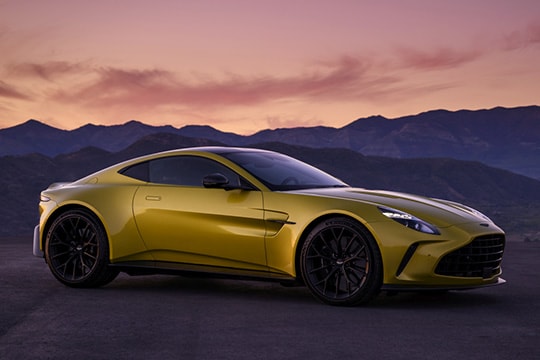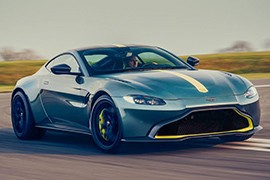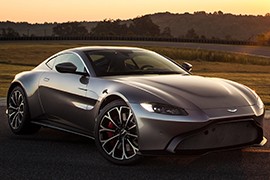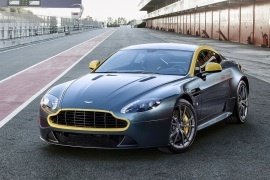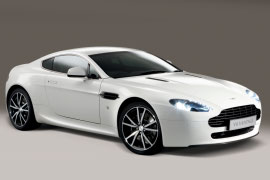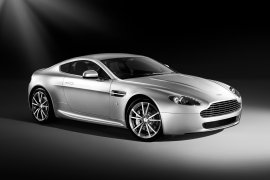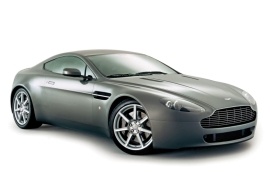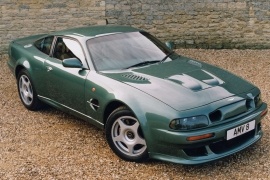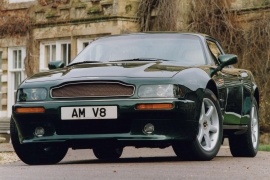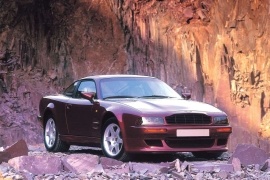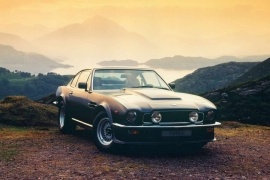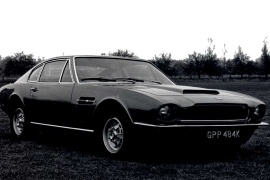ASTON MARTIN V8 Vantage Models/Series Timeline, Specifications & Photos
First production year: 1973
Engines: Gasoline
Body style: Coupé (two-door)
The British car manufacturer Aston Martin unveiled the 2024 Vantage, and while it wasn’t an entirely new generation, it was a massive upgrade over its non-facelifted sibling.
In late 2017, Aston Martin unveiled a new sequel to the Vantage V8 saga, which it updated seven years later in 2024. But unlike other facelifts where some would need a keen eye for detail to notice the differences, the 2024 version was heavily revised. Besides the exterior look, the British sports car gained an overhauled interior and a big bump in the horsepower department. As a result, it tried to chase down the famous 911 to claim the crown for the best daily driver European sports car.
At the front, the 2024 Vantage looked striking with its huge grille that was 40 percent larger than on the non-facelifted version. This was flanked by two functional vertical venting scoops that cooled the front brakes. Above them, the automaker placed new Matrix LED headlights that ensured customers they’d get a better night driving experience. The car was also 30 mm (1.2 inch) wider than before.
On its side, the car featured new, enlarged front fenders adorned by functional vents behind the wheel arches and a classic Aston Martin badge on them. The door frameless door mirrors were black and available in carbon fiber finish. On the doors, the automaker installed flush door handles that folded into the panels and popped out at the touch of a button from the key fob. The 2024 Vantage received three types of 21-inch forged wheels but with different designs. Finally, at the back, the enlarged quarter panels received new vents on their rear side. Under the bumper, the automaker installed four round tailpipes that poked through the newly designed diffuser.
Inside, the 2024 Vantage was a completely new car. Its dashboard was new and sported slimmer vents. Furthermore, the 10.25-inch touchscreen for the infotainment system was integrated into the center console that housed the gear selector and the start button, among other physical buttons around. Fronting the driver was a completely new digital instrument cluster that replaced the previous three-dial setup from the 2017 model year. Like any other proper sports car, the 2024 Vantage featured a pair of sports seats with integrated headrests that hugged their occupants and kept them in place during high-speed cornering.
But the most significant upgrades happened under the skin. Up front was an AMG-engineered twin-turbo 4.0-liter V8 powerplant that sent 665 PS (655 hp) to the rear wheels via a ZF eight-speed automatic. The bump in power over its predecessor was an impressive 155 PS (153 hp). Thanks to the bonded aluminum platform, the 2024 Vantage had a 29% stiffness increase in the rear side under hard accelerations. To keep the car under control, the adaptive dampers were new and provided a quicker reaction time. Finally, to stop the vehicle, Aston Martin installed massive 400 mm (15.7-inch) rotors up front and 360 mm (14.2-inch) discs in the rear.
Limited to 200 units produced, the 2019 Aston Martin Vantage AMR was launched just a day before the penultimate round of the FIA Endurance Championship, the birthplace of the Vantage AMR.
Aston Martin had a long motorsport history before launching the Vantage AMR. It wasn't the only AMR ever built by the British car manufacturer. Previously, it built the four-door Rapide and the previous Vantage in 2017, and also the DB11. Unlike those, the 2019 Vantage AMR was available exclusively with a 4.0-liter twin-turbo V8 engine provided by Mercedes-AMG mated to a 7-speed manual gearbox.
On the outside, the look was enhanced with the addition of carbon fiber, which could be found on the front spoiler, the side exhaust vents on the front fenders, and the side sills. A carbon-fiber roof and mirror cases were noticeable, and, in the rear, a newly designed bumper that integrated the rear diffuser was also made out of carbon-fiber completing the overall look. A quad exhaust was present, instead of the regular, dual type.
Inside, the carbon-fiber fever was noticed on more elements from the dashboard to the center console. Apart from that, the interior was enhanced with the extensive use of the Alcantara. But the designers could have used an aluminum gear-lever knob instead of a plastic one. The AMR didn't forget about modern technologies such as an infotainment unit, or air-conditioning.
By using a manual transmission, a mechanical differential, and the extensive use of the carbon-fiber, the Vantage AMR saved about 200 kg (440 lbs) of weight. It also lightens up the braking system by using carbon ceramic brakes a lighter, 20” wheels. To help the drivers with the manual transmission, the AMR does the rev-match with up-shifting and downshifting.
Aston Martin finally replaced the previous version of the Vantage after it kept it on the market for twelve years, which was an incredibly long life for such a grand tourer in the modern era.
But the change has finally happened, and the British brand created a completely new model unrelated to its predecessor. Basically, it was the start of a new era for the car manufacturer, and it used the base of the 2019 Vantage V8 on other vehicles that it introduced later, such as the DBX SUV. So, it was more than just a new car; it was the brand's rebirth under better stars than under the blue-oval marque that owned it between 1991 and 2007.
The 2019 Vantage V8 kept the same overall shape of a grand tourer shared by its predecessors but with a bit more styling. While other models were penned by Ian Callum, this one was designed by Marek Reichman. He created a low nose and slim headlights with LED lamps instead of halogen or Xenon. As a result, the car looked meaner and more aggressive. The bumper incorporated the lower grille that was broad and extended at the bottom by a massive splitter. From its sides, behind the front wheel wells, Aston Martin created exhaust vents harmoniously sculptured and extended onto the door panels. These aerodynamic details extracted the air trapped in the wheel well, reducing the lift and lowering drag resistance. From its profile, the 2019 Vantage showed its raked windshield and the curved sloped-down greenhouse. On top of the vehicle, the automaker created two creases on the roof that enhanced the aerodynamics as well. Finally, at the back, the tailgate featured a ducktail at the back. On the lower side of the rear fascia, the carmaker installed a big diffuser adorned by carbon fiber elements and two exhausts that poked through it.
Inside, the automaker did what he knew best: to create a mix of luxury and sporty feeling rarely equaled by any other car manufacturer in the world. The Alcantara-wrapped interior sported carbon fiber details on the center console and vents. Behind the steering wheel, Aston Martin added large paddles mounted on the column. To top it all off, the carmaker installed a pair of high-bolstered bucket seats and covered them in Alcantara as well. Fronting the driver was a three-dial digital instrument cluster that provided essential data for the vehicle. Furthermore, a touchscreen sat atop the center stack for the infotainment system.
Under the hood, the automaker installed an AMG-sourced V8 engine. Thanks to the turbochargers, the four-liter powerplant sent 503 HP (510 PS) to the rear wheels via an eight-speed ZF gearbox mounted on the rear axle to help the car achieve a 50/50 weight distribution. Last but not least, a limited-slip differential ensured that maximum traction was achieved all the time.
Aston Martin created another special edition for its aging Vantage in 2014, but it wasn't just about some fancy new colors and designer wheels; it was a sportier Vantage with a tuned suspension and a more potent engine than the rest of the V8 range.
The Vantage N430 was the last edition of the Vantage, and the British car manufacturer produced it in 2014 because, starting with 2015, Europe switched to Euro 6 emission standards, and the mighty grand tourer vehicle couldn't pass them. Nevertheless, this special edition was a car that involved the driver more than most other Aston Martin vehicles produced after it.
Aston Martin introduced the Vantage in 2005 and kept upgrading it and reshaping it over the years. Still, the basic shape of the car remained the same. At the front, the N430 featured the same headlights with an organic shape and adorned by LED daytime running lights. The main grille was surrounded by a yellow trim and adorned with vertical and horizontal slats. Under the bumper, in the air dam, the automaker placed a second air intake to help cool the engine. It was obviously a car designed for days and good weather since the N430 didn't have any fog lamps. Despite several updates and refreshes, the car had the same profile as the 2005 Vantage. The raked windshield and short roof were followed by a sloped-down rear windscreen, which ended into a duck-tail on top of the rear fascia. Finally, at the back, the taillights sported clear lenses, and below the bumper, the automaker installed a wide diffuser, which incorporated the exhausts, one on each side of the vehicle.
Inside, the cabin showed its age even though the automaker tried to conceal it with Alcantara trims and leather. Still, the high-bolstered sports seats with high backs and integrated headrests resembled those from a race car. In front of the driver was the same instrument cluster as in the rest of the range, with wide and clear dials for the speedometer and tachometer flanked by the fuel gauge on the left and the water temperature on the right. But the entire ambiance was also luxurious. Aston Martin knew that its customers didn't want a race car for the road with a stiff suspension and a loud interior with no stereo in it. As a result, the British car manufacturer installed a Bang&Olufsen sound system so the car's occupants could enjoy longer rides.
Under the hood was the same 4.7-liter V8 carried over from the Vantage S, which sent 430 HP (436 PS) to the rear wheels via a six-speed manual or a seven-speed automated gearbox developed by Prodrive. Furthermore, the limited-slip differential helped the car put all that oomph to the road and provide excellent performance for the Vantage N430.
In 2006, in a daring quest, a road-registered Aston Martin V8 Vantage entered the 24h of Nurburgring race. It was a slightly modified version of a street-legal vehicle. It didn't win but it finished in fourth place in its class and 24th overall.
The result was even more important since it wasn't driven by professional racing drivers. There were company employees, including the Aston Martin CEO, Dr. Ulrich Bez. The result was good enough to make the brand repeat the stunt in the following years with other different vehicles, including the four-door Rapide.
The Vantage N420 was a car designed to remember the big success achieved by the team in 2006. It was based on a standard Aston Martin Vantage. The standard Vantage offered 420 hp, the same as the special edition. But the N420 featured some carbon-fiber elements that helped decrease the total weight by 27 kg (60 lbs). In the back, the car featured a diffuser to help reduce the drag and increase the cornering speed.
Inside, there were options for street, comfortable yet bolstered seats, or carbon-fiber seats. The car featured standard Bluetooth connectivity and parking sensors. On the door sills, there was a carbon-fiber decal with the Vantage N420 logo on it.
For the color scheme, the N420 was available with a two-tone livery, to celebrate various racing Astons. Some of them were more inspired than others.
The car featured the "sports-pack" stiffer suspension, offered as an option for the regular V8 Vantage. The transmission was a six-speed with paddle-shifters behind the steering wheel.
It was the end of the road between Ford and Aston Martin, but the car was facelifted before their divorce. Thus, the 2008 V8 Vantage was the last to wear that many parts from Ford's parts bin.
By 2008, the world financial crisis started to claim its victims in the automotive industry. Jobs were slashed, models were cut, and the big carmakers began to see where they could find buyers for their money-loosing brands. And yet, Aston Martin dared to push and introduced a facelifted version of the V8 Vantage, in both shapes as a coupe and a convertible. Maybe it didn't necessarily want to, but it was forced by the introduction of the Euro 5 emission standards.
At first sight, it was an update dictated by the accountants. As a result, there were almost no exterior changes for the beautiful British GT. Still, the carmaker managed to squeeze a new 20-spoke, 19" light-alloy wheels in the standard spec, while a set of five-spoke lightweight aluminum wheels was on the options list.
Inside, Aston Martin upgraded the dashboard to a similar-looking design to the one installed in the DBS. In addition, a new HDD-based navigation system was placed on the center stack. Furthermore, the driver benefited from the paddle-shifters mounted behind the steering wheel to manually change gears without getting their hands off the wheel. Last but not least, there was a new key made from steel, polycarbonate, and glass that had to be inserted into a slot and pushed to start the engine.
Under the hood, the DB8 received an improved, 4.7-liter V8 engine that provided 420 hp (320 kW). All the oomph reached the rear wheels via a six-speed manual, while a six-speed automatic was offered as an option.
In 2005, Aston Martin was still linked with Jaguar and Ford. But it was still a luxurious GT car that featured a different approach to its customers and a different market.
The 2005 Geneva Motor Show was the place where Aston Martin decided to unveil its latest creation, the V8 Vantage. Even if it shared some components with some vehicles from Ford, its overall look was different and it gathered the attention from the deep-pockets buyers.
The 2005 Aston Martin V8 Vantage was based on its own developed platform, named VH from the second generation. The car featured a twin grille design, with the upper side in the traditional Aston Martin shape and a wide one on the lower part of the bumper. The headlights featured the daytime running lights on the inside, with a twin bulb design for the low and high-beams. Two air-vents were noticeable on the hood, closer to the windshield. The rear design showed the muscular arches of the quarter panels. The two, round exhausts were going through the lower side of the bumper. The horizontal V-shaped taillights were a specific styling element of the car.
Inside, the luxurious GT offered leather-covered sport-bucket seats. The dashboard used the same unusual tachometer that went counter-clockwise. But, with some buttons carried over from some Ford models.
Under the hood, there was a 4.3-liter engine hand-built in Cologne-Germany by Aston Martin engineers. It featured a dry-sump lubrication system so the engine would support hard driving conditions. It was tested for 12.000 miles in Dubai. A 6-speed automatic gearbox was offered from the launch and it was mounted in the rear, in a transaxle system.
In 1959 Aston Martin won the 24-hour race from Le Mans with Caroll Shelby and Roy Salvadori at the wheel, and four decades later, the British automaker produced a limited edition of the V8 Vantage that celebrated that success.
It was a huge victory for the small British company, and it won not because they had a better car but a better team. Still, a win it's a win, and that allowed it to brag about even forty years later when it introduced the limited-edition V8 Vantage Le Mans at the 1999 Geneva Motor Show in March. But it wasn't just a regular vehicle with some badges and new spoilers. It was based on the V600 version. It was the most powerful car on the market, and only 40 units were made.
Judged from the outside, it was easy to see similarities with the rest of the V8 Vantage range, such as the Audi-borrowed headlights and Volkswagen taillights. But the front grille featured a panel that almost blocked the entire cooling area, apart from two side openings. The lower bumper featured an aggressive spoiler that was designed to grab the air and push the car's nose to the ground. On the sides, the scoops behind the wheel arches were functional and decreased the lift provoked by the air trapped inside the wheel wells. Strangely, though, there was no wing or spoiler on the trunk.
Inside, the British automaker carried over the door handles from Jaguar and some buttons and switches from Ford. But the rest of it was a luxurious, leather-wrapped interior that expressed nothing more than luxury and comfort.
Under the hood, the twin-supercharged V8 powerplant was pumped-up to 600 hp (608 PS), which made it the most powerful vehicle on the market at the time of its launch. The transmission was a five-speed manual-only affair.
Aston Martin introduced in 1996 a longer wheelbase version of the V8 Vantage, which was already on the market since 1993, and the result was spectacular.
The British carmanufacturer was in deep need of money and tried its best to please its customers, who complained about the interior room and even about comfort on longer trips. That led to a redevelopment of the V8 Vantage's platform, which included a longer wheelbase. Unfortunately, that led to additional costs, and the car rivaled the price of a Rolls-Royce Silver Seraph.
The upgraded model featured the same front fascia as the short-wheelbase version since it didn't have enough money to create a more comprehensive update for the vehicle. It kept the front fascia with its triple-headlamps under a clear cover and the same silver mesh grille. Aston Martin's design team installed air vents behind the front fenders, which extracted the air trapped in the wheel well. Thanks to its longer wheelbase, the carmaker could move the rear seats backward, and thus it added significant legroom for the backseat passengers. In the rear, the carmaker installed round taillights, with big turn signals on the outer side. The reversing light was installed very low into the rear apron.
Inside, Aston Martin didn't spare a dime to make one of its most luxurious cabins ever. Wood trims accompanied the Connely leather-wrapped seats and door panels. The only plastic parts were for the buttons and a few switches. Some of them were carried over from other production vehicles, such as Ford.
Under the hood, Aston Martin installed a supercharged V8 paired with a 4-speed automatic transmission provided by Chrysler.
The 1993 Aston Martin V8 Vantage was like a Pink Floyd song: powerful, authentic, and yet hard to understand by many due to its uncanny sound.
Built as a higher-powered version of the Virage, the V8 Vantage was a grand tourer made to cover hundreds of miles in a single day without taking a toll on the driver's back. Its look was menacing, and the sound it emitted was brutal. And yet, it featured some unusual solutions for such an expensive GT.
For some, the front of the vehicle was original, although it sported Audi 100 headlights. Its grid-like grille was shared with the Virage, but the air dam was different. That was designed to stop the air from getting under the car and create a ground effect. It also sported a center secondary mesh grille flanked by two air intakes mounted there to cool the front disc brakes. On the sides, the massive (for those times) 18" light-alloy wheels had a six-spoke design, and finally, at the back, the automaker placed two round taillights on each side and a diffuser flanked by two round exhausts under the bumper.
The interior was luxurious, and it could accommodate up to four people. As expected, those seated in the rear couldn't enjoy the same level of comfort as the driver and their side passenger on their high-bolstered seats. In addition, the wood-trimmed dashboard featured a plethora of dials and gauges spread both in front of the driver and above the center stack. The wood veneers also covered the center console and parts of the door cards as well.
Its twin-supercharged V8 engine produced 550 hp and 550 lb-ft of torque from the 5.5-liter displacement. And still, it was not a supercar; it was one of the greatest and most underrated GT vehicles of its time.
It was one of the most famous Aston Martin in the '80s after it starred in the James Bond franchise movie “The living daylights” and it was a supercar of its era, even if Aston Martin considered it as a GT.
While the world recovered from the oil crisis, the British car-company Aston Martin needed a new generation for the luxury coupe and convertible market. But with the bigger engine from the Lagonda under the hood, the new model was named Vantage. It was the original Vantage.
From the outside, the British Grand Tourer featured a low height, a long hood with a bulge in the middle, that differentiated it from the other Aston Martin V8 (Series 3) model. In the front, it featured two round headlights and two fog-lights installed in the grille. The fastback shape and the proportions of the car gave it a nickname of a British Muscle-car.
Inside, it was a marriage between wood and leather, with chromed metal parts as rings of engagement on the instrument cluster. The 2+2 seating was more like a 2-seat cabin. The low driving position and the floor-mounted gears-stick were part of the car's charm.
Under the hood, there was a 5.3-liter engine that offered 394 hp when it was introduced. Over the years, the engine was upgraded up to 403 hp after 1986. The early models featured a 5-speed manual, while the later ones received a 6-speed manual.
In 1972, the British car manufacturer introduced the second series for its DBS, and since it dropped the inline-six powerplants and left only the V8s under its hoods, it also used a new moniker: the V8.
Grand touring cars were highly appreciated by those with deep pockets, for whom the oil crisis was not exactly a problem, at least not from the financial point of view. So pouring gallons of gasoline into a V8-powered GT was not an issue for them as long as that vehicle provided the pleasure of driving across continents. And that's exactly what this model was.
Sporting the same shape as its predecessors, as a fastback coupe, the 1973 V8 featured a new front fascia. Its mesh grille followed a more pronounced shell shape and was not as rectangular as before. But, undoubtedly, the most significant element that differentiated the Series 2 from the Series 1 was the hood scoop, which was tall and functional. At the back, the sloped-down greenhouse looked like it was a hatchback, but it wasn't; it was a three-box coupe.
Inside, the lavish cabin boasted leather bucket seats at the front and a bench seat for two in the back. While there was not exactly a four-passenger vehicle, it was considered a 2+2. Nevertheless, those seats could've been used as an additional storage area for long travels. The driver fronted a complex instrument panel filled with no less than four gauges for various information about the engine status. In addition, Aston Martin installed large dials for the speedometer and tachometer.
Since the old inline-six was dropped, the 5.3-liter V8 was the only option. It was fed by four double-barrel Weber carburetors that helped the powerplant produce over 300 hp. At that time, Aston Martin didn't state its official power output. Still, when fitted with a five-speed manual, the V8 could get from naught to sixty (0-97 kph) in less than six seconds, and a mere 0.3 seconds later for the versions fitted with a Chrysler three-speed auto.
